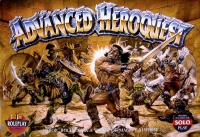Advanced Heroquest
Advanced Heroquest was a 1989 board-game released simultaneously with HeroQuest, published by Games Workshop and designed by Jervis Johnson. The game was illustrated by Gary Chalk, Paul Bonner, Mark Craven, Wayne England (rulebook cover) and John Sibbick (box cover). Subtitled "Heroic roleplay in a world of magic & mayhem" the game was part of Games workshops big box "3D Roleplay Hobby Game" line (along with Dark Future and Adeptus Titanicus) and cross-marketed with Heroquest from MB Games.
Contents
Gameplay
Advanced Heroquest uses a modular board and the use of henchmen however, the basic concept is the same: players control four heroes who venture into a dungeon to fight monsters and gain treasure while one other player (the games master) controls the monsters). The included quests featured the heroes entering a Skaven-infested dungeon in order to retrieve a magical artifact.
The major differences to HeroQuest include:
- more gritty combat rules
- random dungeon generation system
- modular game board
- ranged combat
- multiple colleges of magic and spell books
- henchmen
- critical hits and fumbles
- fate points (the "undo" feature)
- bestiary with many creatures
Advanced HeroQuest also includes rules for using the characters and monsters from HeroQuest, as well as some other Warhammer creatures should players want to do so.
Games Workshop set Advanced HeroQuest in the Warhammer setting. The campaign world is easy to ignore, however, should players rather use the game as a generic dungeon-crawl.
The game is supplied with Skaven figures that make up the quest within the rulebook. The exact same Skaven, henchmen and hero miniatures were also included in Mighty Warriors, also by Games-Workshop.
The game used 12 sided dice (D12). Both heroes and monsters were defined by the following characteristics: Weapon Skill (WS), Ballistic Skill (BS), Strength (S), Toughness (T), Wounds (W), Speed (SP), Intelligence (Int), Bravery (Br).
Combat worked by rolling a certain amount on a D12, determined by how high the opponent's WS was compared to your own in the case of melee or how far away the opponent was and how good your BS in the case of ranged combat.
Damage worked by rolling a number of D12s determined by your Strength and what weapon you were using. The number of dice that equalled or exceeded your opponent's Toughness was the number of Wounds you inflicted.
While the only monster figures included in the set were the rat men known as Skaven, statistics were provided for many generic fantasy monsters that appeared in the Hero Quest game and more.
The Terror In The Dark Expansion
An expansion to Advanced HeroQuest called Terror In The Dark written by Graeme Davis and Carl Sargent, and illustrated by Tony Ackland, Stephen Tapan, Colin Howard, Paul Bonner, Jes Goodwin , Russ Nicholson, Fangorn, Adrian Smith, Martin McKenna, Pete Knifton and Dave Andrews. . Terror In The Dark added new monsters, henchmen, treasures and spells - most of which had already been published in White Dwarf (see Advanced Heroquest/White Dwarf Index). An original quest was also included, titled The Quest of the Lichemaster which featured the heroes being pitted against the Lichemaster, based on the character from the scenario pack for Warhammer 2nd Edition. The expansion contained no plastic miniatures but several cardboard components.
White Dwarf Articles
There were several Advanced Heroquest quests and articles published in White Dwarf during the games run. See the Advanced Heroquest/White Dwarf Index
See also
External links
- Board Game Geek entry for Advanced Heroquest http://boardgamegeek.com/boardgame/1758/advanced-heroquest
- Greywolfs Advanced Heroquest page http://greywolf.critter.net/ahq.htm
- Heroscribe http://www.heroscribe.org/baloban/ADV2.htm
